Tatra OT-810: the make-up "Ganomag"
OT-810 can be called the make-up “Hanomag” in every sense of the word. This comparison not only underlines the general external similarity of the two combat vehicles, but also the successful film career of the Czechoslovak armored personnel carrier. After the war, especially after the withdrawal of the army of Czechoslovakia, the Tatra OT-810 armored personnel carriers very often appeared in military films because of their outward resemblance to the Wehrmacht armored personnel carrier during the Second World War. Already decommissioned combat vehicle successfully removed in the movie today, and is also actively used by reenactors around the world. The latest film, in which Tatra OT-810 armored personnel carriers were shot, is the film “Ilyinsky Frontier”, which filmed in Moscow Region in November 2018. The world premiere of this film is scheduled for May 2020 of the year and will be timed to the 75 anniversary of the Victory in the Great Patriotic War.
After the end of World War II, Czechoslovakia was again restored as an independent state. Almost immediately, the question was outlined of how to arm the country's army. For the first time, the armament and arsenal of the German army became a huge help. The Czechoslovak army was armed with medium Tanks Pz. IV, anti-tank self-propelled guns Hetzer, armored personnel carriers Sd.kfz. 251 and German half-track tractors. Apart from tanks, all the rest of the equipment during the war was produced at factories in Czechoslovakia, so there were simply no problems with the operation and repair of these combat vehicles. As the Soviet Union armed Czechoslovakia with military equipment of its own production, tanks and self-propelled guns inherited from Nazi Germany were decommissioned from the army, and trucks were replaced with new Tatras, but an overlay came up with armored personnel carriers. The USSR did not produce enough armored personnel carriers in order to freely send them also to its allies. Only the BTR-40 and BTR-152 that appeared in the country were actively supplied to the Soviet Army, in the mid-1950s it was still far enough to saturate the Soviet units with such armored vehicles. This was the reason for the resumption of production in Czechoslovakia of a seriously modernized German half-track armored personnel carrier.
The Tatra OT-810 armored personnel carrier was a deeply modernized version of the German Ganomag and the world's only version of the semi-tracked armored personnel carrier that was produced after the end of the Second World War. The armored personnel carrier developed in the 1950s went into mass production in the 1958 year and was produced up to the 1963 year. During this time, in Czechoslovakia, they managed to produce about 1800 combat vehicles - 1250 linear armored personnel carriers, the rest - special vehicles based on it. Production of armored personnel carriers OT-810 was carried out at the plant "Podpolyanske building", located in the city of Detva (Slovakia).
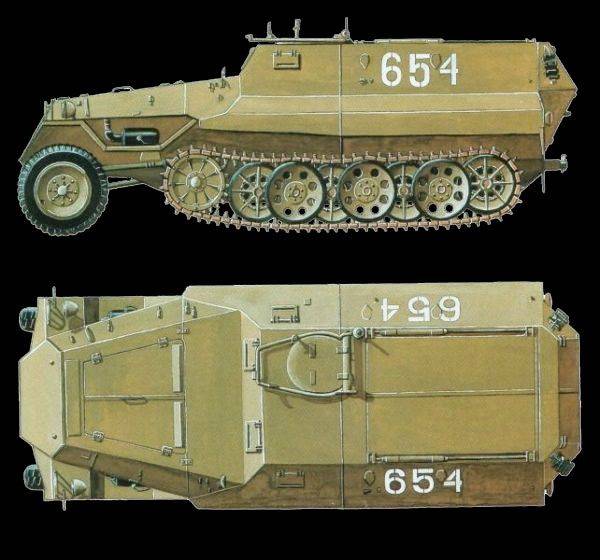
During the war years, the German semi-tracked armored personnel carriers Sd.Kfz.251 for the needs of the Wehrmacht were also produced by the Czech company Skoda at the plant in Pilsen. After the end of the war, a new armored personnel carrier was created at the Tatra plant in Koprshivnitsa for the needs of the Czechoslovak army. The combat vehicle, which received the designation OT-810, externally retained its similarity to its German progenitor, borrowing the original layout of the Sd.Kfz.251 / 1 Ausf.D armored personnel carrier. At the same time the car was significantly modified in terms of some design solutions. The armored personnel carrier received a new air-cooled diesel engine manufactured by Tatra, a fully enclosed armored body and an improved undercarriage.
That case has undergone significant modernization. The fighting compartment was expanded, loopholes for firing from personal rifle weapons landing, the form of the stern was borrowed from the variant of the Sd.Kfz.251 / 1 Ausf.C armored personnel carrier. From above, a full-fledged armored roof appeared, which protected the landing not only from bullets and shrapnel on the battlefield, but also from precipitation in the form of rain and snow. The roof of the hull was also equipped with a hatch that could be used by the commander of the combat vehicle. A turret was installed on it to accommodate the 7,62-mm machine gun, originally it was vz.52, but later it was replaced by another Czech machine gun vz.59. The booking of the hull has not undergone major changes, the armor sheets themselves were located at rational inclination angles. The thickness of the frontal armor did not exceed 15 mm, along the sides of the hull - 8 mm. If the armored hull “Ganomaga” was assembled section by section with bolts during the war years, the body of the Czechoslovak armored personnel carrier OT-810 was all-welded.
The body of the new armored personnel carrier was welded from sheets of armored steel on a squared steel massive frame. The layout of the case remained unchanged and had a bonnet circuit. The engine was located in front. Under the armored hood of the OT-810 armored personnel carrier there is a 8-cylinder V-shaped diesel engine of air cooling manufactured by Tatra company. It was a Tatra T-928-3 engine with a displacement of almost 10 liters. At 2000 rpm, this engine developed a maximum power of about 122 hp. On the German “Ganomagah” serials, the Maybach gasoline engines were installed, the power of which did not exceed 100 hp. In addition to the engine on the OT-810 was changed and the shape of the muffler. The gas tank was located in the floor.
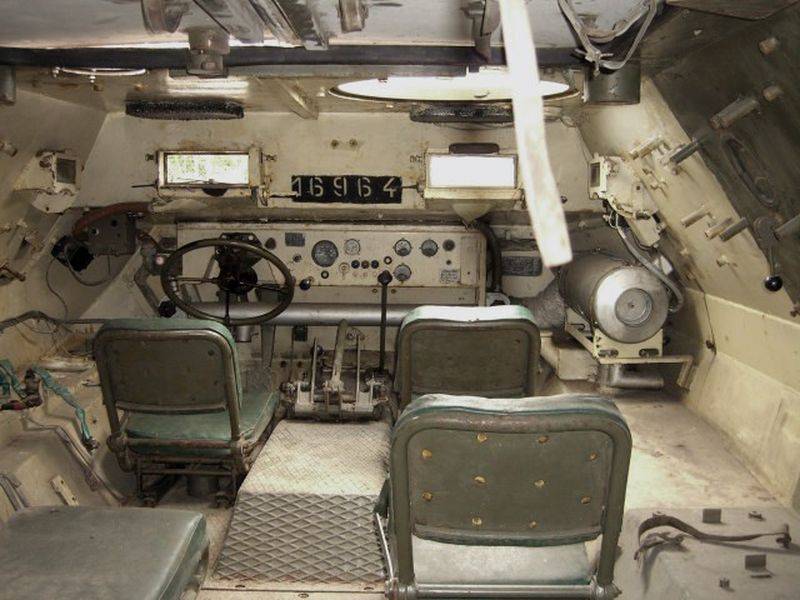
Immediately behind the hood was located the office of control with the places of the commander of the combat vehicle and the driver. Behind them was the troop compartment, which was in no way separated from the headquarters, and could hold up to 10 fully equipped soldiers. The commander and the mechanic drive of the car observed the road and the battlefield through the observation windows located in the front plate, as well as on the sides of the hull. These windows were covered with special armored covers with viewing slots, as well as bullet-proof triplexes. Inside the corps, the paratroopers were positioned as follows: directly behind the mechvod and the commander were two paratroopers, their seats were located in the direction of the vehicle, the other 8 people sat along the sides of the hull facing each other. The landing and disembarking of the paratroopers was carried out either through the stern doors, or through flaps and a hatch in the hull roof.
The OT-810 armored personnel carrier was controlled using the steering wheel, which has the same angle of inclination unusual for a modern driver as on the German counterpart (the steering wheel is tilted down), as well as the levers that controlled the onboard brakes and allowed the driver-mechanic to steer the tracks, which significantly improved the maneuverability of the BTR. The suspension of the Czechoslovak armored personnel carrier had a semi-tracked layout, as on the German counterpart. The front wheels had a spring suspension (one transverse spring was used) with hydraulic shock absorbers. The wheels had developed lugs and were tubeless, filled with foam and were resistant to bullet hits. The rear propulsion unit was tracked and retained the chess arrangement of the track rollers. Such an arrangement of the rollers increased the survivability of the machine and the smoothness of the course, but seriously worsened maintainability, especially in field conditions. The outer row consisted of three rollers, the inner one of four rollers, and the middle row consisted of six rubberized rollers of large diameter, front leading and rear guide wheels. Basic rollers were stamped, which facilitated the process of their production. Tracked suspension - torsion bar. The caterpillars themselves were also changed, rubber pads were removed from them and the lugs were increased.
Tatra OT-810 armored personnel carrier could be used to transport trailers weighing up to three tons. In addition, part of the armored personnel carriers was equipped with a system of protection against weapons of mass destruction, a special filtering unit was installed on them - the HLF. The presence on board of the FVU led to a decrease in the number of paratroopers, since a considerable amount of space was located on the starboard side of the troop compartment of the armored vehicle to spend the elements of the filtering unit.
In this form, the Czechoslovak armored personnel carriers were actively exploited until the middle of the 1960-s, when they were replaced by new BTR OT-62 and OT-64. From the middle of the 1960's, OT-810 armored personnel carriers began to be transferred to auxiliary units or converted into anti-tank guns armed with 82-mm recoilless guns. Also, this model continued to be used as a conventional tractor, including for various artillery systems. The anti-tank OT-810 remained in service until the mid 1980-ies. At the same time in the 1980-ies OT-810 began to massively decommission the army of Czechoslovakia, and in 1995, the last of the remaining copies were removed from storage.
On the basis of the armored personnel carrier OT-810, a certain analogue of the tank destroyer was also created. This combat vehicle received the index OT-810D. The chassis has not undergone any changes, but the fighting compartment was changed, the roof disappeared. Due to this, it was possible to place the conning tower with armored shields that flip to the sides, they defended the 82-mm recoilless gun M59. If necessary, the gun could be relatively easily removed from the armored vehicle and used as an ordinary towed artillery system. The angle of vertical guidance of the gun ranged from -13 to + 25 degrees. The crew of the OT-810D tank fighter consisted of four people: the driver, commander, gunner and loader. At the same time, the height of the combat vehicle with an instrument and wheelhouse increased to 2,5 meters.
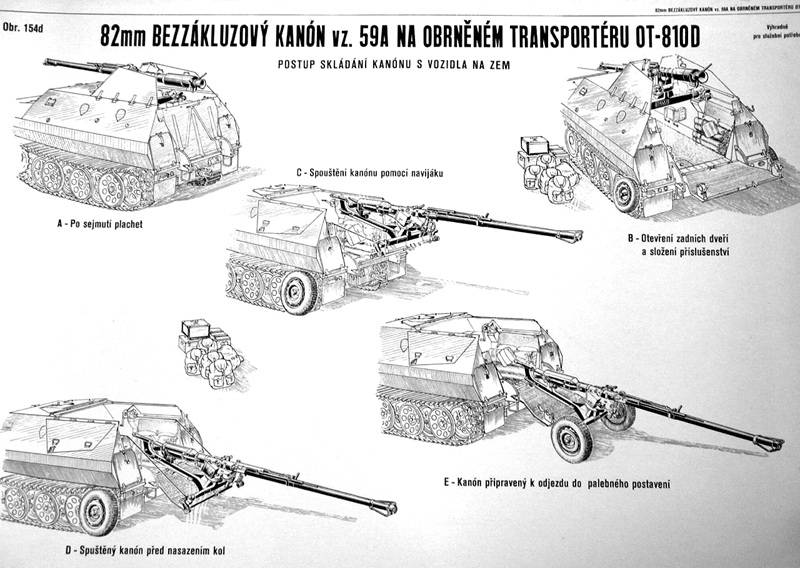
Interestingly, the German semi-tracked armored personnel carrier Sd.Kfz.251 gave life not only to the post-war Czechoslovak armored personnel carrier. His distant ancestor was considered a Daimler semi-tracked truck. The truck was specially manufactured in Germany for Portugal and equipped with rubber bands that connected the drive wheels with an additional pair of guide wheels. Such a simple caterpillar design allowed the car to confidently overcome areas of soft ground.
Performance characteristics Tatra OT-810:
Overall dimensions: length - 5,71 m, width - 2,19 m, height - 2,10 m.
Reservations - 8-15 mm.
Combat weight - about 9 tons.
The power plant is a diesel 8-cylinder engine of air cooling TATRA T-928-3 with power 90 kW (122 hp).
Maximum speed - up to 60 km / h.
Power reserve - 600 km.
Capacity - 2 (crew) + 10 (landing).
Armament - 7,62-mm machine gun vz.59 or 82-mm recoilless gun M-59A.
Information sources:
http://eragun.org/cheh/bronemashyny/ot-810.html
http://pobeda.poklonnayagora.ru/description/166.htm
http://www.vojenskatechnika.sk/ot810/ot810.htm
Open source materials
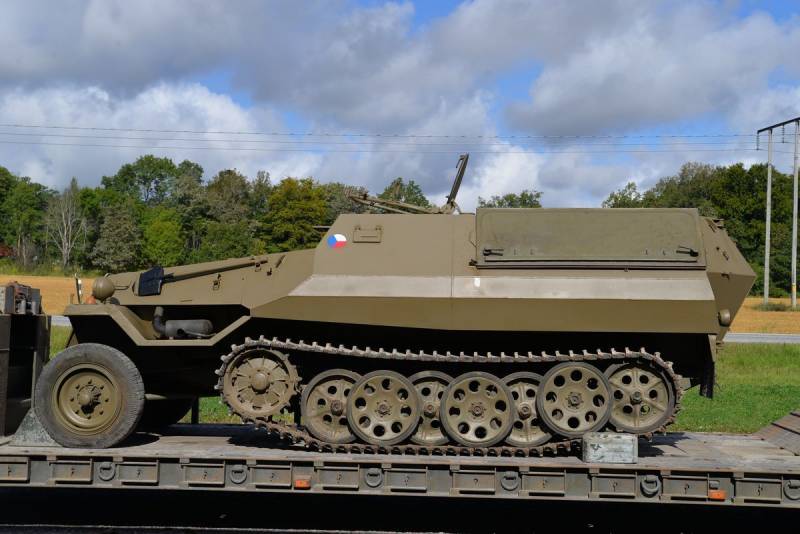
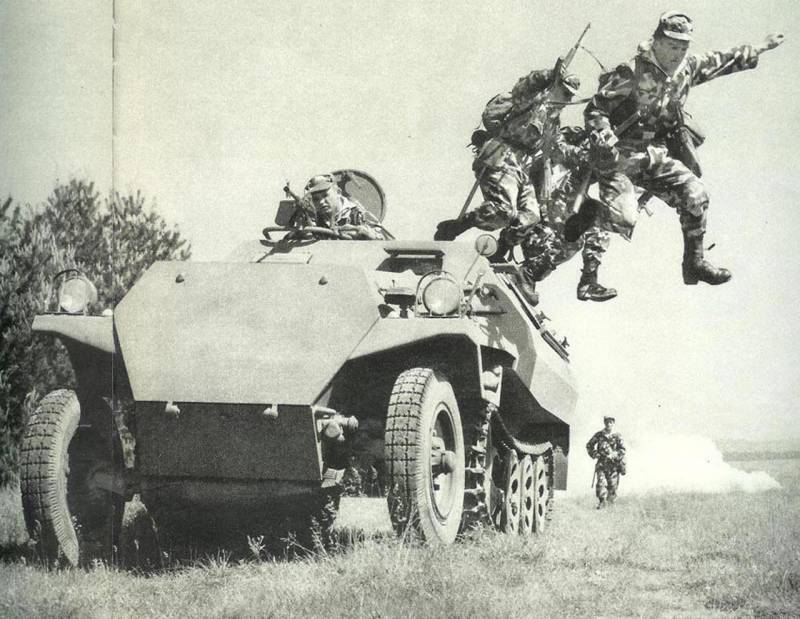
Information